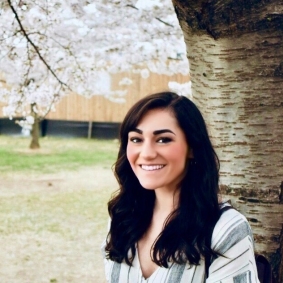Knauss legislative fellowships in Congress help build careers — and they're fun and educational. See our video and fact sheet for details.
Katie Hornick

Fellowship Institution:
National Marine Fisheries ServiceStart Year:
2020Katie Hornick is working in the NOAA National Marine Fisheries Service’s Office of Habitat Conservation as a Habitat Restoration Specialist. She is working on a range of topics related to developing monitoring and evaluation approaches for Deepwater Horizon restoration.
Katie obtained her bachelor’s degree in natural science from Loyola Marymount University in Los Angeles, CA. After graduating from Loyola Marymount University, Katie spent a year and a half in Puerto Montt, Chile, studying the effect of salmon aquaculture on microbial diversity and community composition of sediments. She then went on to pursue a Ph.D. at the University of Maryland Center for Environmental Science’s Horn Point Laboratory in Cambridge, Maryland under the direction of Dr. Louis Plough. Her dissertation research examined, focusing on Harris Creek, the largest oyster sanctuary in the world. She used molecular tools to compare genetic diversity of restored and wild oysters and built a computer model that integrated oyster genetics and biology with real-world restoration scenarios.
In her spare time, Katie enjoys making jewelry, kayaking, hiking, and exploring new places with her pug, Oliver.
Call for Symposium Presenters and Authors
The Chesapeake Rising: Innovative Law and Policy Solutions for Climate Adaptation in Coastal Communities symposium will explore key legal and policy considerations that affect climate adaptation strategies. It provides a unique opportunity for upper-level law students and early-career lawyers to present and publish their legal scholarship.
Program Announcements
-
-
Maryland Sea Grant has program development funds for start-up efforts, graduate student research, or strategic support for emerging areas of research. Apply here.
News and Blogs
Video Gallery
Sea Grant Film Explores a Diminishing Smithville
Smithville is a community on Maryland’s Eastern Shore, on the edge of the Blackwater National Wildlife Refuge. A century ago, Smithville had more than 100 residents. Today, it has four, in two homes: an elderly couple, and one elderly woman and her son, who cares for her.
Featured Fellow
Featured Research Project
Developing a habitat model for mysids, an important link in Chesapeake Bay food webs
Mysids are important mesozooplankton prey for many species of fish in Chesapeake Bay and are an important link in transferring energy from lower to upper trophic levels. Mysids also serve as biological vectors for benthic-pelagic coupling due to their diel vertical migration and omnivorous prey-switching behavior, which makes mysids important regulators of food web architecture. Despite their central role in coastal food webs, surprisingly little is known about mysid ecology and dynamics in Chesapeake Bay.
The Blue Crab: Callinectes Sapidus
An essential resource for researchers, students, and managers. Get your copy today!


©2025 Maryland Sea Grant. All rights reserved.
5825 University Research Court, Suite 1350 | College Park, MD 20740
Phone: (301) 405-7500 | Fax: (301) 314-5780 | Contact Us



